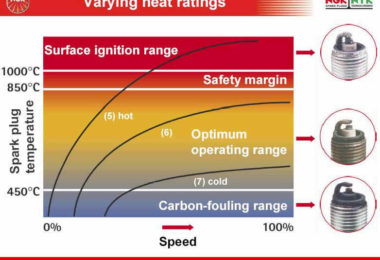A spark plug has one major job in life, to ignite the air & fuel mixture in a gasoline engine.
It’s pretty simple, but why are there so many spark plugs options for the same engine? One major component is called “Heat Range”
For proper operation, a spark plug should be approximately between 500°C (932°F) and 800°C (1472°F). The two most common causes of spark plug problems are carbon fouling (below 450°C) and overheating (above 800°C). Overheating can lead to detonation, pre-ignition, and/or engine damage, while carbon fouling can cause misfiring, poor performance, or a dead cylinder. Spark plug manufacturers modify the “heat range” of plugs by manipulating the follow design criteria:
- Surface area and/or length of the insulator nose
- Thermal conductivity of the insulator, center electrode, etc.
- Structure of the center electrode such as a copper core, etc.
- Relative position of the insulator tip to the end of the shell (projection)
This diagram from NGK Spark Plugs USA, illustrates this nicely:

In the Ford world common NGK heat ranges are:
- TR45 Stock in some NA applications
- TR55 Basic stock supercharged applications
- TR6 Recommened for Higher than stock boost levels
- Heat Range 7 for high to extreme boost applications
Choosing the correct heat range is vital for best operation of your performance engine.
